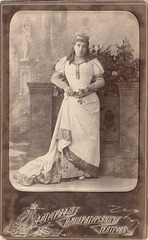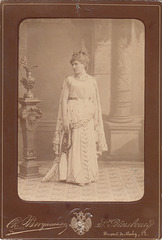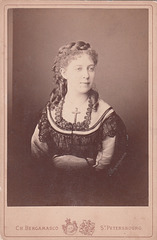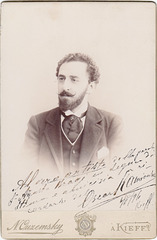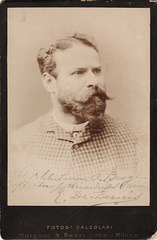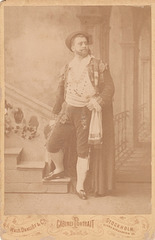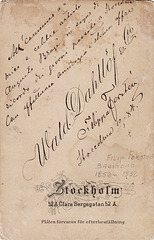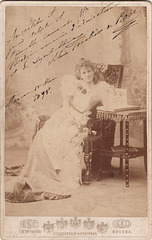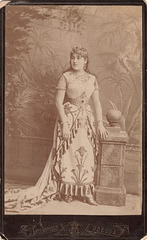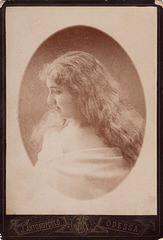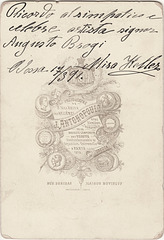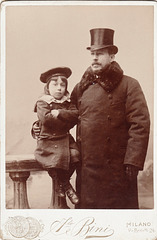Bialystok-Stavenuiter's photos
Eugenia Mravina and Maria Dolina by Bergamasco
| |
|
Eugenia Mravina, born Maria Konstantinowa Mavrinskaya (1864-1914); Russian soprano.
Her singing teacher in St. Petersburg was the baritone Ippolit Petrovich Pryanishnikov and she also received a training as a ballet dancer. To complete her vocal studies she moved to Berlin, where she was a pupil of Désirée Artôt and to Paris, where she was educated by St. Yves Bax. In 1886 she made her debut at the Mariinsky Theatre in St. Petersburg as Gilda in Verdi's "Rigoletto". Until 1900 she belonged to the great and celebrated singers of this Opera House. Her most memorable roles were Antonida in Glinka's "A life for the Tsar", as Ludmilla in Glinka's "Ruslan and Ludmilla", as Tatjana in Tchaikovsky's "Eugen Onegin", as Marguerite in Gounod's "Faust", as Marguerite de Valois in Meyerbeer's "Les Huguenots", as Violetta in Verdi's "La Traviata", as Gilda in Verdi's "Rigoletto", as Elsa in Wagner's "Lohengrin" etc. Because she had received a professional training as a dancer, she also performed very successfully as prima ballerina at the Mariinsky. She made guest appearances in Moscow (Bolshoi) and other major Russian cities. In 1891 she appeared in London at Covent Garden. In 1894 at the Moscow Conservatory she created the role of Fornarina in Arenski's "Raphael". In 1895 at the Mariinsky she sang at the première of Rimsky-Korsakov's "Christmas Eve" the role of Oksana. She had a very attractive stage appearance and was an actress of high intelligence and dramatic intensity. Her voice was described as radiant in tone and technically excellent. She was one of those singer personalities who founded the great tradition of Russian opera.
Maria Dolina, born Maria Ivanovna Sajuschkina Gorlenko (1868-1919); Russian contralto.
Her voice was discovered by Garcia-Wilde and trained mainly by Kondratiev. Final studies were carried out with Carelli in Naples, with Mastriani in Milan and finally in Paris. In 1886 she made her debut at the Marienskij Theatre in St. Petersburg as Vanya in Glinka's "A life for the Tsar" (Ivan Susanin). She was engaged immediately and remained at the Mariiinsky until 1904. Here in 1890 she sang at the premiere of Borodin's "Prince Igor" under the direction of Edouard Naprawnik. Also in 1890 she created the role of Polina at the premiere of Tchaikovsky's "Pique Dame/Queen of spades" and from the same composer in 1892 the role of Laura in "Iolanta". In 1896 she sang at the Mariinsky the role of Hansel in the Russian premiere of Humperdinck 's "Hansel and Gretel". She made guest appearances in Moscow and other Russian theaters and abroad in Paris, Berlin, Vienna, Budapest, Constantinopel, Sofia, Belgrad, Zagreb, Dresden and Rouen. Her repertoire consisted of more than 50 roles, mostly in the field of Russian and French Opera. As a concert singer she was very successfully in a vast repertoire.
On the photo Eugenia Mravina is seen left as Antonida and Maria Dolina right as Vanya in Glinka's "A life for the Tsar".
Medea Mei-Figner by Mariinsky Theatre
| |
|
|
|
Medea Mei-Figner, born Amedea Mei Zovaide (1859-1952); Italian soprano/contralto.
She was born in Florence and studied with Bianchi, Carozzi-Zucchi and Panofka. In 1874 she made her debut at Sinaluga as Azucena in Verdi's "Il Trovatore". During the following nine years she appeared in various Italian theatres. She made guest appearances in Madrid, Barcelona, London, Bukarest, Russia and South America. At that time her repertory included Amneris, Ulrica, Leonora (in La Favorita) and Carmen. Step by step she began to shift into the soprano repertory. She sang Valentine in Les Huguenots, Charlotte in Werther and Margherita in Mefistofele. During her appearances in Milan she met her future husband, the Russian tenor Nicolai Figner (1857-1918). She married him in 1889. They both joined the Imperial Opera in St. Petersburg, where they had very succesfull careers. The singer couple had a large influence on Russian musical life of their epoch. The with them befriended composer Tchaikovsky completed on their country estate in the vicinity of Tula his opera "Pique Dame/Queen of Spades", which he dedicated to the two artists. In the premiere in St. Petersburg (1890) Nikolai Figner sang the the role of Hermann and Medea Mei-Figner the role of Liza. They also created leading roles in the première of Tchaikovsky’s "Iolanta" (1892); Nicolai as Count Vaudémont and Medea as Iolanta. They sang at the première of 2 operas by the Czech composer and Mariinsky conductor Edouard Nápravnik: "Dubrovsky" in 1895 and "Francesca da Rimini" in 1902. She spent her life in Russia but remained an Italian trained singer. She appeared mostly in Italian and French operas. The couple was much loved by the Tsar’s family and they were guests at all the elegant drawing-rooms of Imperial Russia. In 1903 the singer couple divorced. In 1904 she made a last operatic tour in South America and continued her career at the Mariinsky Theatre in St. Petersburg until her farewell performance as Carmen in 1912. She finally left Russia in 1930 and settled in Paris where she died in 1952.
Wilhelmina Raab and Ivan Melnikov by Bergamasco
| |
|
On the photo Wilhelmina Raab is seen as Tamara and Ivan Melnikov as The Demon in Rubinstein's opera "The Demon". Raab and Melnikov created these roles at the worldpremière in 1875 at the Mariinsky Theatre in St. Petersburg
Wilhelmina Raab, born Wilhelmina Bilik (1848-1917); Czech soprano.
She studied singing at the Conservatory of St. Petersburg with Henriette Nissen-Saloman, as well as at the Conservatory of Vienna with Falconi. In 1871 she made her debut at the Imperial Opera in St. Petersburg as Mathilde in Rossini's "William Tell". Here she remained until 1884. During this period she sang at various important world premières of Russian operas. In 1874 she created Natalya in Tchaikovsky's "Oprichnik", in 1875 Tamara in Rubinstein's "The Demon" and in1876 Oksana in "Vakula the smith" also by Tchaikovsky. In 1877 she sang at the Russian première of Rubinstein's "The Maccabees" the role of Noëmi. In 1880 she created the role of Alyona Dmitriyevna in Rubinstein's "The merchant Kalashnikov" and in 1881 Agnès Sorel in Tchaikovsky's "The maid of Orleans". She had a virtually unlimited creative power, what enabled her to perform multiple roles in the same Opera: Gorislava and Lyudmila in Glinka's "Ruslan and Ludmilla", Kupava and the title character in "Snegourotchka/The Snow Maiden" by Rimsky-Korsakov, Queen Marguerite and the page Urbain in Meyerbeer's "Les Huguenots" and Donna Anna and Donna Elvira in Mozart's "Don Giovanni". Among her most memorable roles were Marguerite in "Faust", Gilda in "Rigoletto", Elsa in Lohengrin and Aida. After she retired from the stage she worked at the Conservatory of St. Petersburg as a vocal teacher.
Ivan Melnikov (1831-1906); Russian baritone.
He studied singing at the Conservatory of St. Petersburg with Gavriil Lomakin and in Milan with Repetto. He started his career at the Opera of Kiev (1865/67). In 1867 he made his debut at the Imperial Opera in St. Petersburg as Riccardo in Bellini's "I Puritani". The first two years he only performed in Italian operas. Then he turned his interest to the independent Russian Opera, whose roles he sang from now on. Until 1890 he was a highly respected member of this leading Russian Opera house. He performed in St. Petersburg in a number of musically and historically important world premieres of Russian operas. In 1872 he created the role of Don Carlos in the premiere of Dargomyshski's "The stone guest" and in 1873 Prince Tokmakov in Rimsky-Korsakov's "The Maid of Pskov". In 1874 he sang the title role in the first complete performance of Mussorgsky 's "Boris Godunow". In 1875 he created the title role in Rubinstein's "The Demon" and in 1890 Igor in Borodin's "Prince Igor". He also created roles in four of Tchaikovsky's operas: Prince Vyazminsky in "Oprichnik" (1874), a devil from hell in "Vakula the Smith" (1876), Prince Kurlyatev in "The Enchantress" (1887) and Count Tomsky in "The Queen of Spades" (1890). In 1890 the highly respected artist ended his career with a performance of Prince Igor. During the years 1890/92 he was general director of the Mariinsky Theatre. In 1897 he undertook a last farewell tour. In 1906 he published his autobiography.
Maria Deysha-Sionitzkaya by Bergamasco (2)
| |
|
Maria Deysha-Sionitzkaya (1859-1932); Ukrainian soprano.
She studied singing at the Conservatory of St. Petersburg with Zwanziger and Everardi. She completed her vocal studies in Paris with Mathilde Marchesi de Castrone. In 1883 she made her debut as Aida at the Imperial Opera of St. Petersburg, where she would remain until 1891. From 1891 until 1908 she was engaged by the Bolshoj Theatre in Moscow. At the première in 1893 of Rachmaninoff's opera "Leko" she created here the role of Zemfira. In 1906 she began a distinguished concert career in Moscow. She had much influence on Russian musical life in those days. In the years 1907/13 she organized concert series in Moscow, where she presented vocal and instrumental music, including contemporary works. In 1907 she founded in Moscow the "Conservatory for the people", which she led until 1913. During the years 1921/32 she worked as a professor at the Conservatory of Moscow. She also staged operas at theaters in Yaroslavl and Moscow. She was generally considered one of the most important Russian singers of her artistic generation.
Maria Deysha-Sionitzkaya by Bergamasco (1)
| |
|
|
Maria Deysha-Sionitzkaya (1859-1932); Ukrainian soprano.
She studied singing at the Conservatory of St. Petersburg with Zwanziger and Everardi. She completed her vocal studies in Paris with Mathilde Marchesi de Castrone. In 1883 she made her debut as Aida at the Imperial Opera of St. Petersburg, where she would remain until 1891. From 1891 until 1908 she was engaged by the Bolshoj Theatre in Moscow. At the première in 1893 of Rachmaninoff's opera "Leko" she created here the role of Zemfira. In 1906 she began a distinguished concert career in Moscow. She had much influence on Russian musical life in those days. In the years 1907/13 she organized concert series in Moscow, where she presented vocal and instrumental music, including contemporary works. In 1907 she founded in Moscow the "Conservatory for the people", which she led until 1913. During the years 1921/32 she worked as a professor at the Conservatory of Moscow. She also staged operas at theaters in Yaroslavl and Moscow. She was generally considered one of the most important Russian singers of her artistic generation.
Oscar Kamionsky by Ouzemsky with autograph
| |
|
|
|
Oscar Kamionsky (1869-1917); Ukrainian baritone.
During the years 1888/91 he studied with Camillo Everardi, Stanislaw Gabel and Josef Paleček in St. Petersburg. He continued his studies in Italy with Rossi in Naples. Here he made his debut in 1891 at the Teatro Bellini. After appearances in Florence and Athens he returned to Russia in 1893 and remained until 1894 at the Charkow Opera. He then sang at the Opera of Kiev (1894/95), the Opera of Rostov (1895/96) and the Opera of Tblissi (1896/1901). During the years 1902/04 he was again the Opera of Kiev, 1904/05 at the Opera House of Tsereteli in St. Petersburg and from 1905/08 at the Zimin Opera in Moscow. In 1909 he made a tour to various cities in Siberia and Japan. In the season 1913/14 he was once again at the Zimin Opera in Moscow. He retired from the stage in 1915. Kamionsky had a relatively small, but beautiful voice with fine upper register. Being master of bel canto and performing the roles of both lyrical and dramatical character Kamiosnky was called the "Russian Battistini".
The dedication to the baritone/tenor Augusto Brogi is written and signed by Oscar Kamionsky. The dedication reads as follows:
Al vero artista della parola,
S.n Augusto Brogi in segno di
stima e amicizia per ri-
cordarsi del
Oscar Kamionsky
'94 Kieff
Emilio de Bernis by Calzolari with autograph
| |
|
Emilio de Bernis, born Emilio Broccardo (1842-1907); Italian baritone.
He participated in the campaigns under general Garibaldi and thereafter he was an officer in the regular army. In 1876 he debuted at the Teatro Sociale di Pordenone as Renato in Verdi's "Un Ballo in Maschera". In 1877 he had his first success –at the Teatro dal Verme in Milan- where he performed the role of Germont Père in "La Traviata". This resulted in appearances at the Teatro Politeama in Genoa and at the Teatro Municipale in Piacenza. In the season 1878/79 he was engaged at the Teatro Liceo in Barcelona and the season 1880/81 in Havana. In 1881 he also debuted at La Scala Milan in the opera "Il Guarany" by Gomes. In 1882 he made guest appearances in Berlin and Warsaw. In 1883 he made a tour through Guatemala. In the following years he continued his career mainly by performing in Italian theaters, making tours through South America and occasional guest appearances in other European cities (Nice, Lisbon). After his voice showed early signs of wear and tear he became a vocal teacher. He died suddenly at Ospedale Maggiore of Milan, where he was hospitalized for a surgical operation.
The dedication on the photo is for the baritone/tenor Augusto Brogi and is written and signed by Emilio de Bernis. The dedication reads as follows:
"Al celebre tenore A. Brogi
affettuoso ricordo dell'amico
E. De Bernis"
Filip Forstén by Dahllöf
| |
|
Filip Forstén (1852-1932); Finnish baritone.
After his first vocal studies at the Conservatory of Helsinki he debuted here as Figaro in Rossini's "Il barbiere di Siviglia". He then moved to Paris for further vocal studies with Masset. Then to Milan for vocal training with Lamperti and finally to Vienna where Pauline Lucca was his vocal coach. In 1878, he undertook an extensive North American tour. In 1880/82 he appeared in Italian theaters and from 1883 until 1887 he was engaged at the Royal Opera in Stockholm. In 1887 he made guest appearances at Vienna and in 1888 at various theaters in Germany (Berlin, Stuttgart etc.). His most memorable roles were Don Giovanni, Figaro, Amonasro, Count Luna, Mercutio and Escamillo. Since 1894 he was a vocal teacher at the Conservatory of the city of Vienna. Before and even during his teaching he developed a successful activity as a concert singer. His many students include: Hermann Gallos, Alfred Poell, Margaret Michalek, Fanny Cleve, Viorica Ursuleac, Alexandra Trianti and Vera Schwarz. The soprano Anna Forstén (1846-1926) was his sister.
Filip Forstén's autograph at the back
| |
|
Filip Forstén (1852-1932); Finnish baritone.
The dedication to the baritone/tenor Augusto Brogi is written and signed by Filip Forstén. The dedication reads as follows:
Al carissimo
amico e celebre artista
Augusto Brogi in segno di
ricordo di giorni passati a Stoccolma,
con affettuosa amicizia e stima offre
Filippo Forstén,
Stoccolma, 10/1 84.
Ortensia Synnerberg by Fedecki with autograph
| |
|
|
Ortensia Synnerberg (1856-1920); Finnish mezzosoprano.
She received her first vocal training in St. Petersburg. In 1875 she made her debut in a concert in Helsinki and then went with a state scholarship for further studies to Milan, where she became a pupil of Francesco Lamperti. In 1877/78 she made guest appearances in Finland -both on stage as in the concert hall- , at London Covent Garden and at the Imperial Opera in St. Petersburg. This was followed by a tour through Italy and in 1881 she performed at the Wiener Hofoper. In 1883 she appeared in Buenos Aires and in Rio de Janeiro. In 1885 she appeared at the court Opera of Moscow in Glinka's operas "Ruslan and Ludmilla" and "A life for the Tsar". In 1890 she participated in a USA tour with the Patti-Opera. In 1891 she created the role of Beppe at the première of Mascagni's "L'amico Fritz". In the years 1896/98 she made guest appearances in Russia (Kiev, Odessa and Rostov) and in Italy ( Rome, Milan, Venice, Florence and Naples). Since 1898 she worked as a vocal teacher in Kharkov. After the October revolution of 1917 she lived there in poor conditions.
On the photo she is seen as Dalila in Saint-Saëns' "Samson et Dalila".
Ortensia Synnerberg's dedication to Auguso Brogi a…
| |
|
Ortensia Synnerberg (1856-1920); Finnish mezzosoprano.
Dedication to the baritone/tenor Augusto Brogi, written by Ortensia Synnerberg. The photo is signed by her on the front. The dedication reads as follows:
Al celebre, grande
insuperabile "Sansone",
ricordo affettuoso
offre
sua "Dalila"
Rostoff, 1895
Alma Fohström von Rode by Trunov with autograph
| |
|
Alma Fohström von Rode (1856-1936); Finnish soprano.
She received her vocal training in the years 1874/77 from Henriette Nissen-Saloman in St. Petersburg, Francesco Lamperti in Milan and Désirée Artôt de Padilla in Paris. She made her debut in 1878 in Helsinki as Marguerite in Gounod's "Faust". In the 1880's she appeared regurlarly at the Opera house of Riga, where she performed Lucia (Lucia di Lammermoor), Marguerite (Faust), Amina (La Sonnambula) and Martha (Martha). In 1883/84 she made an extended tour through South America, in 1885/86 a tour through the USA (with the Mapleson Opera Company) and in 1887 a tour through England. Here she performed in 1887 at Covent Garden the role of Leïla in the English première of Bizet's "Les pêcheurs des perles". In the 1888/89 season she was engaged by the Metropolitan Opera of New York. Here she made her debut there as Queen Marguerite in Meyerbeer's "Les Huguenots " and also performed Bertha in Meyerbeer's "Le Prophet", Mathilde in Rossini 's "Guglielmo Tell" and Marguerite in Gounod's "Faust". The greatest successes of her career she had in the years 1890/1900 at the Opera Houses of St. Petersburg and Moscow. From 1889 until 1917 she lived in St. Petersburg. In 1909 she appeared for the last time on stage in Helsinki and then became a vocal teacher at the Conservatory of St. Petersburg. After the revolution of 1917 she left Russia and worked as a teacher at the Conservatory of Helsinki and since 1920 for a few years at the Stern'schen Conservatory in Berlin. After her marriage she performed under the name of Alma Fohström-von Rode. She was a coloratura soprano of the greatest technical perfection. Her sister Elin Fohström (1868-1949) was also a well known soprano who made a career under the name of Elina Vandár.
The dedication on the photo is for the baritone/tenor Augusto Brogi and is written and signed by Alma Fohström. The dedication reads as follows:
Au celebre et
grand artiste et
l'aimable camarade Mr.
Brogi, souvenir d'admiration
et de sympathie.
Alma Fohström de Rode.
Moscow, 15 Mai 1895
Jules-Célestien Devoyod by Unknown with autograph
| |
|
|
Jukes-Célestien Devoyod (1841-1901); French bass-baritone.
He studied at the Paris Conservatoire National with Nicolas Levasseur and Joseph Couderc. In 1867 he made his debut at the Grand Opéra in Paris as Nelusco in Meyerbeer's ''L'Africaine''. From 1870 on he appeared at the major French provincial theatres of Lyon, Marseille, Bordeaux, Toulouse and he also made some guest performances abroad. In 1873 he was engaged by the Opera House in New Orleans (USA). In the 1874/78 seasons he appeared at the Théâtre de la Monnaie in Brussels and in 1888 he sang at the Teatro de l'Opera in Buenos Aires. Since 1875 he had great success at the Imperial Opera of St. Petersburg. In 1883, 1884, 1887 and 1891 he appeared at Covent Garden, where he created the role of Ivan Susanin in the English première of Glinka's ''A Life for the Tsar'', a part which he also performed in 1890 in the French première of the opera in Nice and in 1896 in the Paris première. In 1893 he sang at La Scala in Milan the role of Wotan in Wagner's ''Die Walküre''. Nevertheless he had his greatest success at the opera houses of St. Petersburg and Moscow as well as at the guest performances and concerts in the centers of the Russian musical life. He passed away quite suddenly during a performance of Verdi's ''Rigoletto'' at the Moscow Hermitage Theatre.
The dedication on the photo is for the baritone/tenor Augusto Brogi and is written and signed by Devoyod. The dedication reads as follows:
Souvenir affectueuse offert à
l'ami Brogi
Jules Devoyod
Mira Heller by Antonopoulo (2)
| |
|
|
Mira Heller (1866-?); Polish mezzosoprano.
She studied singing with Biernacki in Staniswalów and with Paschalis-Souvestre in Lwow (Lemberg). In 1887 she made her debut at Lemberg in the title role of Bizet's "Carmen". In 1890 she made guest appearances at Krakov, Milan and Venice. In the season 1891/92 she appeared at the opera in Odessa and Kiev. In 1892 she was engaged at the Wiener Hofoper and the Budapest Opera. In 1893 she had a great success at the Grand Opera in Warsaw, where she performed the roles of Mignon, Carmen, Amneris (in Aida), Santuzza (in Cavalleria rusticana) and Selika (in L'Africaine). In that same year she continued her vocal studies with the famous soprano Pauline Lucca. In 1894 she made her Metropolitan debut in New York as Mignon, followed by performances as Carmen and Santuzza. She then returned to Europe and continued her career in Poland and Russia. After her marriage she left the stage, but in 1902 she gave some occasional concerts in Krakow under the name of Maria Olszewska. After the first world war she went to the USA where she lived until her death.
On the photo she is seen as Amneris in Verdi's "Aida".
Mira Heller's autograph at the back (2)
| |
|
Mira Heller (1866-?); Polish mezzosoprano.
Dedication to the baritone/tenor Augusto Brogi, written and signed by Mira Heller. The dedication reads as follows:
Ricordo di grande simpatia
al bravo, simpatico, buono
signor Brogi Augusto
Mira Heller
Odessa 17/3 1891
Mira Heller by Antonopoulo (1)
| |
|
Mira Heller (1866-?); Polish mezzosoprano.
She studied singing with Biernacki in Staniswalów and with Paschalis-Souvestre in Lwow (Lemberg). In 1887 she made her debut at Lemberg in the title role of Bizet's "Carmen". In 1890 she made guest appearances at Krakov, Milan and Venice. In the season 1891/92 she appeared at the opera in Odessa and Kiev. In 1892 she was engaged at the Wiener Hofoper and the Budapest Opera. In 1893 she had a great success at the Grand Opera in Warsaw, where she performed the roles of Mignon, Carmen, Amneris (in Aida), Santuzza (in Cavalleria rusticana) and Selika (in L'Africaine). In that same year she continued her vocal studies with the famous soprano Pauline Lucca. In 1894 she made her Metropolitan debut in New York as Mignon, followed by performances as Carmen and Santuzza. She then returned to Europe and continued her career in Poland and Russia. After her marriage she left the stage, but in 1902 she gave some occasional concerts in Krakow under the name of Maria Olszewska. After the first world war she went to the USA where she lived until her death.
Mira Heller's autograph at the back (1)
| |
|
Mira Heller (1866-?); Polish mezzosoprano.
Dedication to the baritone/tenor Augusto Brogi, written and signed by Mira Heller. The dedication reads as follows:
Ricordo al simpatico e
celebre artista signor
Augusto Brogi
Mira Heller
Odessa 17/3 1891.
Augusto Brogi by Bini
| |
|
Augusto Brogi (1847-1917); Italian baritone and tenor.
He studied under Romani and Bianchi at the Istituto Musicale di Firenze in Florence. In the season 1871/72 he successfully made his debut (as a baritone) in Teatro Pagliano in Petrella's "Contessa di Amalfi". After performances in various theatres of Florence, he moved to Rome to sing at the Apollo theatre, then to Milan where he sang at La Scala, Dal Verme and the Teatro Manzoni.This was followed by appearances in Venice at the Teatro La Fenice and in Bologna at the Teatro Comunale. When Brogi was preparing himself for the role of Iago in Verdi's "Otello" he discovered that the tenor role of Otello was closer to his heart. And after 15 years of being a baritone, he moved to tenor roles which he continued for another 15 successful years. The historical chronicles say his easy way of singing, his extremely soft and pleasant timbre, his delivery, classic gestures and interpretation, made it possible for the gifted artist to play a very broad range of roles. Later on his career as he became more and more successful, he also performed in most of the major theatres of Paris, Vienna, St.Petersburg, Stockholm, Pest, Copenhagen, Moscow, Buenos Aires and Rio de Janeiro. His wide repertoire included 70 operas with famous roles by Verdi, Rossini, Bellini, Donizetti and Bizet among his favourites.
Jump to top
- ipernity © 2007-2024
- Help & Contact
|
Club news
|
About ipernity
|
History |
ipernity Club & Prices |
Guide of good conduct
Donate | Group guidelines | Privacy policy | Terms of use | Statutes | In memoria -
Facebook
Twitter


